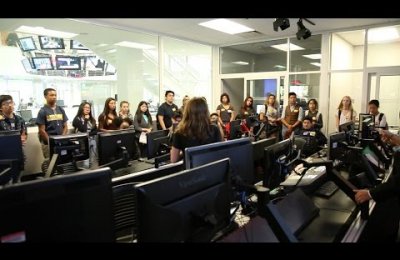For every six students who applied to attend USC Annenberg this academic year, only one was admitted.
It’s no surprise, then, that the recently matriculated freshmen, along with newly arrived transfer students, master’s students and doctoral students, collectively possess impressive transcripts, CVs and resumes as well as myriad diverse experiences, interests, manners of thinking and ethnic and geographic heritage.
“A student body that looks like the future of America came together really richly,” says Geneva Overholser, USC Annenberg’s journalism school director.
"They are a very impressive group," says Larry Gross, USC Annenberg's vice dean and communication school director.
The students are trailblazers, too. Eighteen percent of the undergraduate Annenberg freshmen and twenty-eight percent of the transfers to Annenberg are the first members of their families to attend college.
Laura Santana is a USC Annenberg master's in journalism student and one of those first-in-family Trojans. The daughter of Mexican immigrants and one of seven children, Santana grew up in Fontana, Calif., about an hour east of the USC campus. Santana is now the first graduate student in her family, and all of her siblings are currently enrolled in institutions of higher learning.
"My parents both wanted to go to college," Santana says, but they couldn't, because having seven kids, you have to make sacrifices."
Santana says she wants to be an entertainment journalist. She's the associate editor of Intersections South LA and has a Neon Tommy assignment. She's also pregnant. "When I graduate with my master's, I'll have a one-year-old," Santana says.
De'Ron Fantroy is another first-in-family college student. Fantroy, a sophomore transfer student in the class of 2014, was born and spent his early years living in South Los Angeles. Fantroy's father, cousins and six of his aunts live within ten minutes of USC.
While Fantroy was in elementary school, his mom moved him and his sister to the Las Vegas area. After a one-year detour to Arizona State University, Fantroy is back in L.A., majoring in public relations, enthralled with his professors and planning how to take full advantage of the internships offered through USC Annenberg.
"My whole life I've been driven," Fantroy says. "I looked at my mom and I saw where she was – struggling to raise two children without going to college. I always knew that I didn't want that for myself and I didn't want that for my mom. I didn't want that in her lifetime to be the only thing that she knew."
These first in family matriculations are particularly important, says Abigail Kaun, associate dean, academic programs and student affairs. "It shows," Kaun says, "that we are able to be a part of the lives of these individuals advancing in mobility in terms of economic opportunities and education."
Journalism school director Overholser and associate directors Bill Celis and Laura Castañeda are each excited about the energy the newcomers possess. This includes a sense of optimism about journalism that had, in some corners of society, been lacking lately.
"We're seeing now the fruits of having moved out of the lament and into an embrace of the future," Overholser says. "Students are seeing that they have a real opportunity to reinvent and the place is charged with excitement about the future."
Lee Ann Sangalang is likewise excited. She's a first-year communication doctoral student focused in part on understanding the effectiveness of health-related information delivered through interactive games and other popular media. "People know that viewers learn from television," Sangalang says. "So how can we make television better so people are learning better things?"
Sangalang earned her B.A. in communication and psychology from the University of Illinois at Urbana-Champaign. She says Annenberg was a "phenomenal choice" for her because of its Hollywood connections, the school's history of education-entertainment crossovers and its commitment to interdisciplinary programs, projects and research. "The fact that people are open to [collaboration] is really important to me," Sangalang says.
Freshman communication major Razan Al Marzouqi hails from Dubai, United Arab Emirates, and is so far impressed with much about her new city and school – "It's a very vibrant place," she says. Al Marzouqi also appreciates the USC Annenberg commitment to civic engagement. During high school, she spent two weeks in Moshi, Tanzania helping build schools and working in an orphanage.
During her senior year, Al Marzouqi interned on the daily television cooking show, Ma Osama Atyab – "It's More Delicious with Osama." (The title character is Osama El-Sayed, the show's chef.) At Annenberg, Al Marzouqi is interning at radio station KXSC, helping create public service announcements and preparing to train for a more formal on- or off-air position.
Al Marzouqi and the rest of the 154 members of the Annenberg class of 2015 arrived as high achievers. The class combined to average a 3.7 high school GPA and a 2051 SAT score – the latter figure placed them in the test result's 95th percentile. The 80 undergraduates who transferred to Annenberg had a 3.67 GPA and ranked in the 93rd percentile.
Thirty-two percent of the freshman and thirty-eight percent of the transfer students self-identify as being from under-represented minority groups – African Americans, Latino and Native Americans. Among those new to the master's program in journalism, forty-four percent of that cohort self-identify as African American, Latino or Asian American.
Beyond all the numbers, of course, are people – and lives being transformed. Back when Laura Santana, the master's of journalism student with six siblings, told her parents that she'd been named an Annenberg Fellow, Santana's mom cried.
Indeed, meeting the parents of students such as Santana leaves a profound and enduring impression. "There probably," Kaun says, "is no more important and moving experience that an educator can have."





![[web series] Campaign Junkie](https://annenberg.usc.edu/sites/default/files/styles/news_index_featured_small/public/media-youtube/d5gbSRAjFwQ.jpg?itok=YP9_X3fc)



